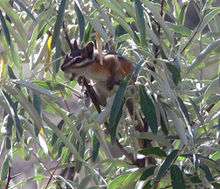Colorado chipmunk
| Colorado chipmunk | |
|---|---|
 | |
| Scientific classification | |
| Kingdom: | Animalia |
| Phylum: | Chordata |
| Class: | Mammalia |
| Order: | Rodentia |
| Family: | Sciuridae |
| Genus: | Neotamias |
| Species: | N. quadrivittatus |
| Binomial name | |
| Neotamias quadrivittatus (Say, 1823) | |
| Synonyms | |
|
Tamias quadrivittatus | |
The Colorado chipmunk (Neotamias quadrivittatus) is a species of rodent in the squirrel family Sciuridae. It is endemic to Colorado, Utah, Arizona and New Mexico in the United States.[1][2]
Description
It can be found most often in coniferous forests, woodlands, montane shrub lands, and alpine tundra habitats. This means that in elevation, T. quadrivittatus inhabits anywhere above 1,500 metres (4,900 ft) and below 2,200 metres (7,200 ft) elevation.[3]
This western American dweller is the largest of the three species of chipmunks found in the Colorado Front Range (which also include the Least Chipmunk and the Uinta Chipmunk). On average it weighs about 62 grams (2.2 oz). Chipmunks are distinguished from ground squirrels in that their faces have a stripe going across under the eye. There are no dimorphic differences between males and females.
Their vocalizations are essential for defending their territories.[3]
Diet
Their diet consists of seeds, berries, flowers and insects.[4] They like to collect food in the fall and cache it for the winter.
Reproduction
Depending on the elevation at which the chipmunk is found, it may range from 1-2 litters. Most commonly copulation occurs in the spring when the chipmunks emerge from their burrows. The females are only receptive of males for a couple of days after emerging from the burrow. About a month after copulation, the female will give birth to a litter that may have anywhere between 5-8 altricial young. Within 40–50 days they will be weaned from their mother.[5]
References
- 1 2 Linzey, A. V. & Hammerson, G. (2008). "Tamias quadrivittatus". IUCN Red List of Threatened Species. Version 2008. International Union for Conservation of Nature. Retrieved 8 January 2009.
- ↑ David M. Armstrong (30 October 2007). Rocky Mountain Mammals: A Handbook of Mammals of Rocky Mountain National Park and Vicinity (Third ed.). University Press of Colorado. pp. 93–. ISBN 978-1-60732-008-1.
- 1 2 Bergstrom, Bradley J.; Hoffmann, Robert S. (1991). "Distribution and Diagnosis of Three Species of Chipmunks (Tamias) in the Front Range of Colorado". The Southwestern Naturalist. 36 (1): 14. ISSN 0038-4909. doi:10.2307/3672112.
- ↑ "Colorado Chipmunk Tamias quadrivittatus". Natural Diversity Information Source. Colorado Parks and Wildlife. Retrieved 2014-08-21.
- ↑ "Colorado Chipmunk: Tamias quadrivittatus". Untamed Science. Archived from the original on 2012-04-22. Retrieved 2014-08-21.
Further reading
- Sullivan, Robert Miles (1996). "Genetics, Ecology, and Conservation of Montane Populations of Colorado Chipmunks (Tamias quadrivittatus)". Journal of Mammalogy. 77 (4): 951. ISSN 0022-2372. doi:10.2307/1382777.
